Multiple Choice
Identify the
choice that best completes the statement or answers the question.
|
|
|
1.
|
This object is made using linking cubes. Draw the front view of this
object. 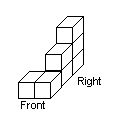
|
|
|
2.
|
This object is made using linking cubes. Draw the top view of this
object. 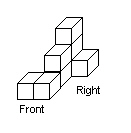
|
|
|
3.
|
This object is made using linking cubes. Draw the front view of this
object. 
|
|
|
4.
|
This object is made using linking cubes. Draw the top view of this
object. 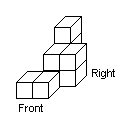
|
|
|
5.
|
These are views of an object built using linking cubes. Sketch the
object. 
|
|
|
6.
|
What shapes do you need to make a triangular prism?
a. | 4 triangles | c. | 2 triangles and 3 rectangles | b. | 1 triangle and 3
rectangles | d. | 4 triangles and
1 rectangle |
|
|
|
7.
|
How many triangular faces are there in a pentagonal pyramid?
|
|
|
8.
|
Which diagram is a net of a square pyramid?  a. | Net A | b. | Net B | c. | Net C | d. | Net
D |
|
|
|
9.
|
Find the surface area of this right rectangular prism.  a. | 156 m2 | b. | 48 m2 | c. | 264 m2 | d. | 132
m2 |
|
|
|
10.
|
A right rectangular prism is made from 19 centimetre cubes.
What is the
surface area of the prism?
a. | 76 cm2 | b. | 78 cm2 | c. | 21 cm2 | d. | 42
cm2 |
|
|
|
11.
|
Calculate the area of this net of a right triangular prism.  a. | 225 cm2 | b. | 207.5 cm2 | c. | 165 cm2 | d. | 147.5
cm2 |
|
|
|
12.
|
Calculate the surface area of this right triangular prism. 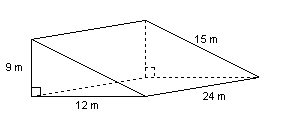 a. | 1080 m2 | b. | 918 m2 | c. | 648 m2 | d. | 972
m2 |
|
|
|
13.
|
Use this net to find the surface area of the cylinder. Give the answer to the
nearest square metre. 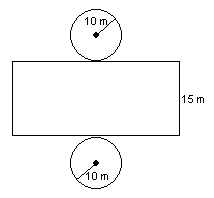  a. | 785 m2 | b. | 1257 m2 | c. | 1100 m2 | d. | 1571
m2 |
|
|
|
14.
|
Find the surface area of this cylinder. Leave  in your
answer.
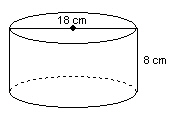
|
|
|
15.
|
A paper cup has the shape of a perfect cylinder that is 6.9 cm tall and 3 cm
across. Find the area of paper needed to make the cup. Use  and give the answer to the
nearest square centimetre. a. | 65 cm2 | b. | 72 cm2 | c. | 79 cm2 | d. | 53
cm2 |
|
Short Answer
|
|
|
16.
|
This object is made using 7 linking cubes. Sketch the top, front, and right side
views of the object. 
|
|
|
17.
|
Sketch the front, left side, and back views of this object. 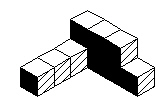 RightFront RightFront
|
|
|
18.
|
Draw a net for a cube and label the faces A, B, C, D, E, and F. When the cube is
made, face A will be opposite face F, face B will be opposite face E, and face C will be opposite
face D.
|
|
|
19.
|
This diagram shows an object with 6 faces. The top and bottom are squares.
The 4 sides are identical trapezoids. Sketch a net for this object. 
|
|
|
20.
|
This object is built using 3 linking cubes. Draw a net of the object. 
|
|
|
21.
|
What shapes do you need to make an octagonal pyramid?
|
|
|
22.
|
A regular octagon is a polygon with 8 equal sides and 8 equal angles.
Describe the shapes you would use to construct a net of each object. a) an octagonal prism
b) an octagonal pyramid
|
|
|
23.
|
This is the net of a right rectangular prism with square bases. What is the
surface area of the prism? 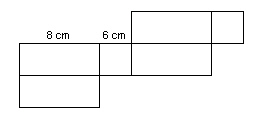
|
|
|
24.
|
Find the surface area of this right triangular prism. 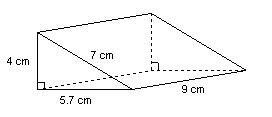
|
|
|
25.
|
Find the surface area of this right rectangular prism. 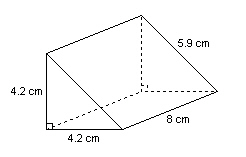
|
|
|
26.
|
Calculate the surface area of this net of a right triangular prism. 
|
|
|
27.
|
A circle has radius 18 cm. Find the circumference to the nearest
centimetre.
|
Problem
|
|
|
28.
|
The diagrams show the front, side, and top views of a symmetrical solid.
Sketch a 3-D picture of the solid. 
|
|
|
29.
|
The diagram shows part of the net of a hexagonal prism. What shapes are missing?
Sketch the complete net. 
|
|
|
30.
|
Marsha was asked to draw the net of a polyhedron. She missed some
faces. Identify the polyhedron and the missing faces. 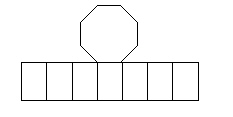
|
|
|
31.
|
Each of the these nets folds to make a regular triangular pyramid. The
bases, marked “B,” are then glued together to form an object. Describe the
object.  
|
|
|
32.
|
A cube is made from 125 centimetre cubes. What is the surface area of the
cube?
|
|
|
33.
|
The right triangular prism and the cube have the same surface area. a) Find the surface area of the
prism.
b) Find the length of an edge of the cube to 1 decimal
place.
Explain your work.
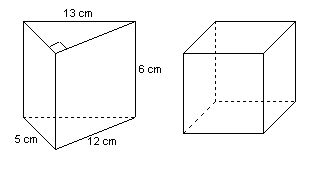
|